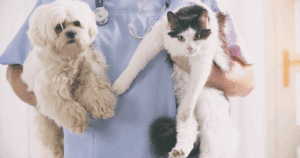
Dental disease in dogs, known as periodontitis, can seriously impact our dog’s overall health and wellbeing,
There is a mountain of evidence in humans and increasing volume in veterinary research to show that poor dental hygiene releases bacteria into the blood stream and is associated with heart, liver, kidney and airway disease as well as diabetes.
More than 80% of dogs over the age of three have some degree of periodontitis, which occurs 5 times more often in dogs than in humans . This is due to dogs’ saliva being more alkaline and very few owners brush their dog’s teeth daily, which would otherwise help to remove the bacteria and food particles that form plaque and lead to dental disease in dogs.
Dogs instinctively hide signs of periodontitis and often by the time signs are visible, the damage has already been done and our faithful companions have been suffering pain for some time.
If anyone has ever brushed their teeth and had some sensitivity or suffered from a hole in their tooth, a tooth abscess or tooth nerve sensitivity, then they should be able to relate to the pain dental disease in dogs can cause their furry friends.
I see too many dogs (particularly those <10kg) in their later years with teeth so rotten that almost all the teeth need to be removed. Owners always seem surprised that the teeth are so bad because “the dog still eats it’s food and seems happy”. It’s only after the procedure that they can see how much pain they were in, often even saying that the dog is behaving like a puppy again!
• bleeding or red gums
• blood on toys or on chew toys
• bad breath known as halitosis
• loose teeth
• head shyness and excessive salivation
• chewing on one side or problems picking up food
• Sneezing or nasal discharge
To help assess the health of your dog’s teeth and to identify any gum disease or other issues, an oral examination will be performed by your veterinarian.
If there is some plaque build up, red or bleeding gums indicating there is an issue or dental disease in dogs, this may then be followed by dental x-rays and further examination whilst under general anesthetic.
When it comes to treatment, a dental scale and polish under general anesthetic is completed to remove plaque and tartar. Loose teeth or those with painful decay through to the sensitive pulp may need to be removed.
General anaesthetics do not harm a dog’s kidneys, provided the presence of kidney disease is identified before the anaesthetic takes place so that measures can be taken to protect the kidneys during the process, such as IV fluids, avoidance of drugs that are metabolised by the kidneys and careful monitoring of blood pressure prior to and during the anaesthetic.
We won’t put an animal over the age of 7-years under general anaesthetic without a blood and urine test, and we do recommend these tests beforehand at any age just to be sure.
Please be aware of anaesthesia-free dentistry being offered by non-veterinary companies.
Trying to do a scale and clean on a dog without an anaesthetic is not only highly distressing for the dog, despite promises to the contrary but it simply fails to remove the problem which is the plaque under the gums. It also misses painful holes as no dental X-rays are taken.
Most humans stress about, or even avoid having a regular scale, so imagine how it is for our dogs who have no idea what is going on and are being held immobile through such a traumatic experience.
These dentals can also only offer a cosmetic clean and there will be problems missed and overlooked which can result in years of chronic pain and health implications. The risks of using anaesthesia on dogs are very small and your vet will perform a full examination and possible blood tests before they even consider recommending one.
Veterinary dentistry needs to be more thorough than that performed on humans, as we can say where it hurts! By using anaesthetic it allows your vet to identify painful disease by doing a thorough examination of all four sides of every tooth, and dental radiographs. Correction of any problems can then occur on the spot. This is not something that can be achieved without the anaesthetic.
Caring for your dog’s teeth should be part of your daily routine. Imagine if you didn’t brush your teeth, it’s no different for our dogs. We brush twice daily and still find out we need fillings yet we expect our dogs teeth to somehow clean themselves!
I strongly advise all puppy owners to start brushing their dog’s teeth immediately with dog-specific toothpaste and either a finger brush or for smaller dogs, I like a toddler’s toothbrush. In my experience, it’s actually easier to brush a dog’s teeth than it is a toddlers,’ so there really is no reason to not get started.
Just remember dogs with existing dental disease will find brushing painful so it’s best to wait until they have had a dental before you start.
You will need dog toothbrush, baby toothbrush or finger brush and dog specific tooth paste as well. Ask your local veterinary clinic to demonstrate the technique. Start slowly, one tooth at a time and reward your dog with praise when they allow you to clean it so that they have a good association with the process. Build up to more teeth with positive reinforcement.
Bones can clean teeth as well, particularly in larger dogs, so while it is not something we Vets tend to recommend, particularly for the smaller designer dogs where gastrointestinal systems and tiny mouths are far removed from their canine ancestors, if a dog has been fed bones without issues such as constipation, diarrhoea and tooth fractures, then I am happy for them to continue if they have very clean teeth!
Just remember that inappropriately sized raw bones cause constipation, intestinal obstructions and tooth fractures, making any issues of dental disease in dogs even worse.
Dental dry food is is larger than standard kibble to reportedly help clean a dog’s tooth while they are chewing into it better – when compared to standard kibble. Keep in mind however that kibble is high in carbohydrates which converts to starch, = sugar… so this needs to be kept in mind and is why dental food alone is not an answer. Read more about feeding a diet high in carbs HERE.
Not all dental chews are equal. One that I do recommend is OraVet Dental Hygiene chews as they can help with bad breath as well as plaque and tartar formation. They contain a special ingredient, (delmopinol), which forms a barrier that helps prevents bacteria from attaching to the teeth. Be sure to take any additional foods/chews into account when calculating your dog’s total daily calorie intake as well to keep their weight controlled.
Dental disease in dogs is a very serious issue that impacts every other part of their body, so taking good care of your dog’s teeth is vital.
About the Author: Dr Melissa Meehan BVSc (Hons), MANZCVS (Int Med) Dr Melissa Meehan is a highly experienced and respected veterinary surgeon with over 14 years experience. Dr Melissa obtained her Members in Small Animal Medicine through examination in 2008 and now runs her own veterinary ophthalmology service www.vetophthalmology.com.au

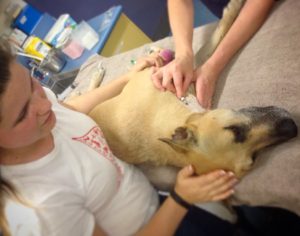
Dog blood donations save lives
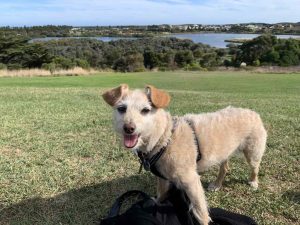
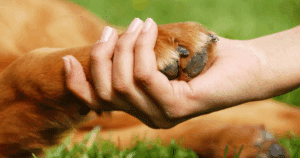
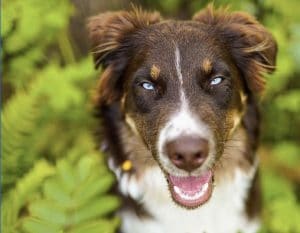
Keeping your pet safe from Paralysis Tick


Get your paws on Lara Shannon’s best selling books ‘Eat, Play, Love (your dog) and World of Dogs.
Available in Australia, USA, UK and Canada.